Introduction
Within This Page
The content of this section of the BEDG in the WBDG is intended solely as a means to create awareness of the relevant topics and concepts. The following information is general in nature, consequently the application of the concepts discussed in real world conditions will vary based on project specific performance considerations and site specific microclimate conditions unique to each project, geographic location and building façade.
In the creative process of building design, a great deal of consideration is given to the physical landscape of a development. Orientation of the future building's footprint, entrances, exits, glazing, interior spaces, etc., are prudently arranged and manipulated to create the most aesthetically pleasing, efficient, and economical plan for the desired use of form and function.
This task of optimizing the readily observable attributes of a plan to its physical landscape can be a daunting task further complicated by the analysis of additional unseen non-physical factors. These factors often include the analysis or impact of: radiant solar angles, sun shadows, noise, vibration, wind force, air quality, pedestrian level winds, snow loading, etc. These last non-physical examples have been traditionally grouped into an area called Environmental or more accurately Microclimate Studies.
The term "microclimate" is defined by Merriam-Webster.com as: "the essentially uniform local climate of a usually small site or habitat". The purpose of conducting these non-physical studies is traditionally two-fold; first to understand the existing microclimate of the site from the various points of study; and secondly to predict the negative impacts, interaction, and influence of the proposed building design on the microclimate and modify the design to mitigate negative impact.
Consequently, the effort to create an aesthetically pleasing, efficient, and economical plan can have immense challenges and trade-offs. That said, the purpose of this particular resource page is to bring awareness to one specific non-physical microclimate factor for consideration in design: winter weather or winter precipitation and its potential for hazardous conditions to people and property if not adequately anticipated. Further it is important to note that the occurrence of hazardous winter ice and snow formations cannot be eliminated and can only at best be reduced in frequency or severity.
Description
The Problem Condition
The following text has been created to raise awareness of an old topic that is of growing concern based on some current trends in the economy and industry at large. Buildings in cold climates have struggled throughout the ages with ice and snow formations that slide, fall, or get windblown from their roofs, ledges, and window sills, causing harm to people and damage to property below. Sliding snow from residential roofs has damaged cars, blocked exits, or even torn off gutters and flashing details. On larger commercial or public buildings the issues are largely the same; however, the potential for damage or injury grows as building surfaces are larger, buildings are taller, and the volume of pedestrian and vehicular traffic increases.
In densely populated urban centers, such as New York City, Boston, Chicago, Toronto, Denver, and Washington D.C.; where prominent tall buildings are constructed on small sites with pedestrian and vehicular traffic mere feet from their base, the tolerance for any potential hazard or interruption of building operations due to falling ice and snow, or the erection of yellow "caution tape" is significantly less. Furthermore, experience has shown that public and urban buildings in general have very little tolerance for shedding ice or snow, regardless of the magnitude of the potential hazard, if it is thought that the occurrence will be perceived as a danger, or damage a building's reputation for safety. This leads to the question: what size of ice or snow piece is acceptable to fall from a building, and how often is it acceptable for ice or snow to fall?
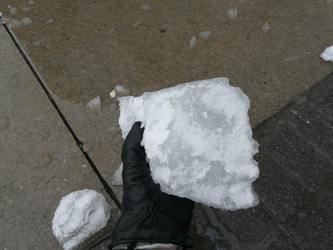
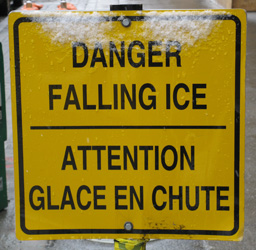
Ice piece found on sidewalk that had fallen from a building ledge. Photo Credit: Northern Microclimate Inc.
A sight becoming far too common on city sidewalks in winter. Photo Credit: Northern Microclimate Inc.
At this time in the advancement of the study topic, the answer to those questions has not been agreed upon within regulatory organizations. Therefore, the best course of action is to seek knowledge and expert advice where possible.
The Art and Science of Ice and Snow Assessment
The assessment of ice and snow focusses on the totality of the winter microclimate in an effort to predict and mitigate a variety of impacts that include:
- falling snow prediction
- falling ice or freezing rain accumulations
- sliding or movement of ice & snow
- melt water control & icicle formation
- wind drifted snow formations
- windblown snow infiltration
- freeze thaw damage
- obstructed views from skylights & clearstory windows
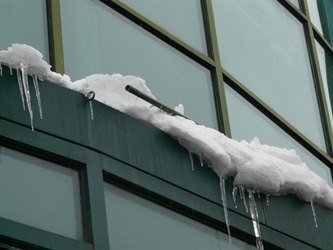
A damaged barrier on a small building ledge. Photo Credit: Northern Microclimate Inc.
Different from a snow loading study, the assessment of ice and snow has no prescribed or regulated criterion, standard or procedure by building codes to assist designers or engineers. Furthermore, an ice and snow assessment focusses on events that would interrupt building operations, services, or create a perceived or real hazard to people or property, compared to snow loading studies that are focused mainly on structural integrity and the potential for failure at a prescribed criterion target. For example: in general, a 50–year return period design criteria for snow loading on a roof surface is prescribed by building codes and is considered acceptable by the established authorities, in regard to the potential for failure of a roof structure. However, there is no corresponding requirement for the acceptability (return period or otherwise) of a falling icicle, windblown ice or snow piece, or sliding ice and snow accumulation from a roof or façade surface.
The current state of the industry is largely due to the complexity of the issues and corresponding number of variables that need to be considered. Furthermore, the analysis and computational models that would be required to predict the potential for building designs to experience hazardous ice and snow formations is beyond the current capabilities of economic study. Thus, the industry must rely on experience-based assessments conducted by consultants having a broad knowledge and experience in: microclimate analysis, building science, cold climate testing, and field investigation.
Characteristics of an Ice and Snow Assessment
The assessment of the potential for ice and snow hazard is generally accomplished through a design review process that considers historical meteorological statistics, local topography and surrounding buildings or structures in combination with the proposed building design. This allows for the frequency, directionality, and severity of winter storm conditions on the site specific microclimate to be evaluated and expressed in terms of potentially problematic conditions. For example: which building façade will be most affected by strong winter winds during snowfall; which direction will freezing rain storms impact the proposed building most frequently; and, where on the exterior of the building are hazardous ice and snow accumulations most likely to form.
If potentially problematic ice or snow formations are anticipated, design modifications can be recommended to reduce the frequency and severity of hazards. The recommendations are typically derived from past experience, including cold room test results and research of previous successful designs and/or field studies. If there is limited knowledge of the performance of a particular design feature, material or the affecting microclimate condition with the corresponding design feature or material, the refinement and validation of a mitigation concept can be recommended. This process is typically accomplished by conducting a full-scale physical test in a controlled cold room environmental chamber. This type of testing can be costly, however it is necessary to allow for the creation of the specific microclimate conditions required (or in question) to validate and refine a mitigation strategy or concept before it is implemented.
To demonstrate the varied aspects of ice and snow assessment, the following topics are discussed:
Building Geometries within their Microclimate
Once historical meteorological statistics have been reviewed and assessed in combination with the proposed building geometries, potentially negative influences of the building's performance within the local microclimate can be realized and improved upon. Examples of negative geometry and microclimate interactions can include:
- orientation of building form (long axis vs. short axis) or shape (curved, round or block forms, etc.)
- complex roof shapes that include slippery sloped surfaces, barrel vaults, roof steps, tower and podium interactions
- complex wall assemblies and sloped surfaces (double façades, trombe walls, complex curtain walls, etc.)
- locations of pedestrian access and/or exterior amenity areas such as courtyards, parking spaces, etc.
If these potential issues are identified and evaluated early in design, the risks of ice and snow hazard can be managed and improved upon, reducing their impact on cost and schedule, and resulting in more appealing aesthetics, as integrated mitigation designs can be investigated.
Envelope Design Considerations
Similarly, the ice and snow assessment can contribute to the decision process regarding envelope design. It is becoming evident that strategies to reduce energy consumption in buildings have a direct impact on the performance of the exterior building skin. Solar shading devices, high-performance wall assemblies and glazing products are generating significant energy savings in terms of long-term building heating and cooling requirements. However, these same strategies are having a negative influence on the accumulation and life span of ice and snow formations on façade surfaces. For example:
- the addition of exterior solar shading devices has significantly increased the exterior surface area available for ice and snow formation
- to obtain increased resistance to heat loss, exterior wall assemblies have in some cases increased in thickness thereby creating larger ledges and window sills
- high-performance glazing products have reduced heat loss thereby promoting increased volumes of ice and snow formations on glazing
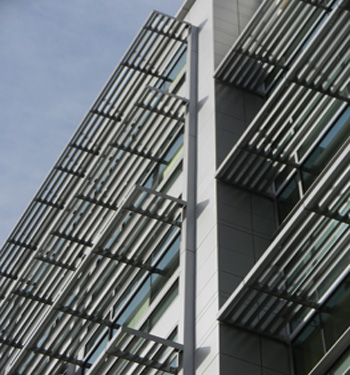
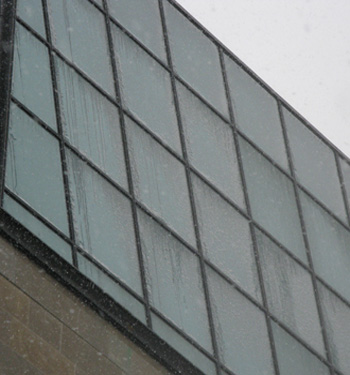
An example of increased exterior surface area created by the addition of sun shades. Photo Credit: Northern Microclimate Inc.
An example of snow formation on curtain wall glazing.Horizontal shading device wraps around the façade of the Center. Photo Credit: Northern Microclimate Inc.
Roof
The roof surface of a building can be a complex region, not only in terms of geometry or the presence of skylights, mechanical equipment, etc., but in terms of ice and snow design. Snow load considerations for ice and snow formations on roof surfaces govern the structural design of the roof and can significantly influence the entire structural design down to the footings of a building. However, as previously discussed, the prescribed snow load process is focused on long-term safety and durability of the structure to avoid catastrophic failure, and is therefore less focused on issues that can influence day to day building operations, public perception and the potential for falling, windblown or sliding snow hazards from a building.
Given these differences, there are two specific areas where the ice and snow assessment can contribute significantly to the structural design. These are sliding or moving snow on slippery sloped surfaces (metal or membrane roofs); and the integrity of the roof drainage path during the winter months.
The first topic has to do with ice and snow accumulations that in the correct meteorological conditions can slide or move, damaging roof projections, mechanical equipment, lighting protection, roof seams, parapet walls and in severe conditions the sliding ice and snow can slide completely from the roof surface damaging property or injuring people below. Circumstances that can lead to a sliding ice and snow scenario can be complex and are not well documented within the industry. This is where an assessment from an experienced ice and snow consultant can prove invaluable, if utilized during initial design rather than in a retrofit condition, which is often the case.
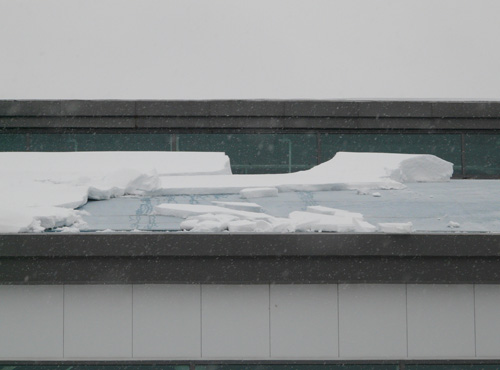
Sliding snow from a roof step on a smooth membrane roof. Photo Credit: Northern Microclimate Inc.
The second topic addresses a key assumption within snow load requirements, that all rain water and melt water from an ice or snow pack on a roof can readily leave the roof surface, therefore eliminating its contribution to the loading condition. However, in complex roof conditions or adverse meteorological conditions, a continuous warm (above freezing) path from source to drain for water flow may not exist. Gutters and roof drains have been known to freeze over with ice formations; alternatively, ice formations (an ice dam) at some location along the drainage path can block large roof areas from draining. Further complicating this issue is the application of heat trace to promote drainage. Often, the addition of heat trace is used to mitigate a potential blockage to the drainage path within gutters, downspouts and on roof surfaces. However, without specific knowledge of the ice and snow formations expected to be experienced, the application of heat trace can be ineffective or in some extreme cases cause problematic or hazardous ice formations. This again is where an assessment from an experienced ice and snow consultant can prove invaluable.
An ice and snow assessment can also help avoid potential issues: at clearstory windows and skylights (maintaining vision or sunlight as well as reducing leakage potential), at mechanical equipment and louvers (reducing snow ingestion or the drifting-in of equipment); and with the placement and size of screen walls and/or parapet walls.
Situating Entrances & Exits
The orientation, layout, or protection of building entrances and exits is also a task where the knowledge gained from an ice and snow assessment can be useful. Questions such as the following can be addressed in a timely and cost effective manner:
- Orientation to prominent winter winds
- Potential for snow infiltration
- Placement and detailing of canopies, wing-walls, wind screens, etc., as effective protection for building entrances and exits
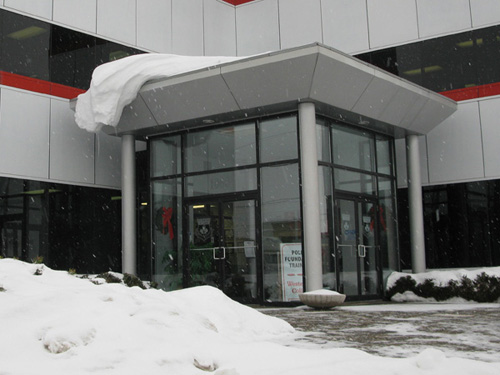
Wind drifted snow cornice at entrance vestibule. Photo Credit: Northern Microclimate Inc.
Building Systems
The choice of building systems can also have an impact on the potential for hazardous ice and snow formations. Modern heating and ventilating systems, in conjunction with improved exterior wall performance, are reducing the reliance on perimeter heating, which in turn can increase the formation of ice and snow on exterior building elements. The overall impact can be a reduction in exterior skin temperature, which is small; however, the resultant increase in volume of ice or snow formation over an entire building skin can create problematic formations.
Planning for Occupancy
As the risk of hazardous ice and snow falling, sliding, or being windblown from a completed building cannot be eliminated under all possible winter conditions, it is therefore beneficial to provide guidelines to the building owner and future operations staff for the creation of operational protocols and winter maintenance plans with respect to ice and snow formations.
Emerging Issues
Energy Efficiency
In an effort to improve the overall energy performance of buildings, the profile of the exterior envelope or façade is changing. An increased use of solar shading devices or double façades has contributed to an increase in falling ice and snow incidents (these elements provide greater surface area for ice and snow to collect). Similarly, an overall increase in façade energy performance (i.e., increased insulation, reduced air leakage and better performing glazing) is contributing to larger ice and snow formations that can be windblown, slide, or fall from a building. Furthermore, the melt and re-freeze of accumulated precipitation on colder exterior surfaces contributes to dangerous icicles or ice sheets that can fall.
Design Trends
Building crowns, wing walls, large mullions, low or no parapets, green roofs, sloped walls and glazing (etc.); all contribute to falling ice and snow. Thus, a review of predicted winter performance of façade details during the design stages of a building is beneficial in identifying and reducing potential falling ice and snow risks.
Material Choices
Slippery roofs and sloped metal or glazed walls can allow ice and snow accumulations to slide and impact building components or areas below the roof or wall, posing a danger to people and property. Currently, there is little guidance available to address moving ice or snow on buildings. However, if the concern is identified during the design of a building and awareness brought to the potential for hazard, solutions can be sought.
Vegetative and cool roof construction techniques can each bring independent challenges to winter design.
The vegetative roof adds roughness and complex geometries potentially increasing the volume of snow collection on the roof surface, as well as increasing the potential for windblown snow transport on the roof surface, creating larger snow drifts in problematic locations. Furthermore, the build-up of soil and planting trays can create challenges with the melt water drainage path, possibly leading to ice formations at un-anticipated locations, creating localized loads. As well, freeze expansion damage to roof materials and flashing details can occur.
Cool roof construction, which is typically made up of increased insulation values combined with light colored roofing materials, has a significant impact on the rate of snow melt. The increased insulation reduces heat loss from the building's interior, while the light colored materials reduce solar absorbance. These two mechanisms can have varying impact on melt water production within an accumulated snow pack depending on the particular exterior weather conditions. However, in its simplest form, the melt out of snow will be slower, making the roof more susceptible to deeper snow, ice, and icicle formations, due to the potential for multiple snow storm events between melting periods. This in turn has implications to snow load assumptions, localized loading due to melt and re-freeze, and the formation of larger ice masses under deep snow formations that can promote sliding ice and snow and/or roof damage due to expansion forces.
New Technologies
Tall buildings can experience frequent wind driven icing at higher elevations. The ice collects in large volumes on parapets, cold walls, antennas, and other structural elements, and then falls. Incidents are rarely reported (publicly); however, they are frequent and increasing due to current design trends and the number of tall buildings. Experienced guidance is required to reduce potential of larger formations.
Relevant Codes and Standards
Building codes and standards have acknowledged the issues surrounding the potential for ice and snow movement on buildings, focusing on aspects of structural design. Some documents have gone further and acknowledge the potential for hazard and damage due to sliding ice and snow formations. However, the existence of procedures, instructions or guidelines that can be implemented to achieve a criteria or standard is not yet available.
Additional Resources
Publications
- Metal Roof Design for Cold Climates, Metal Construction Association.
Published Papers
- "Dam Ice Dam", ASHRAE Journal - Building Sciences 2010 by J. Lstiburek. June 2010.
- "Danger: Falling Snow" by D.A. Taylor. Published in Volume 35 Issue 1 of Canadian Architect, Reprinted in Construction Practice: Selected Applications in Construction Technology Section 2 (NRCC - 35475), 1990.
- "Minimizing the Adverse Effects of Snow and Ice on RoofsDownload MP-01-5663,%20Minimizing%20the%20Adverse%20Effects%20of%20Snow%20and%20Ice%20on%20Roofs.pdf", Proceedings of the International Conference on Building Envelope Systems and Technologies (ICBEST-2001) by J. Buska and W. Tobiasson. Ottawa, Canada: 2001.
- "Sliding Snow and Ice on Buildings: a balance of risk cost and aesthetics", Proceedings of Snow Engineering V by C.J. Williams; M. Carter; F. Hochstenbach and T. Lovlin. London, England: Published 2004.
- "Sliding Snow from Sloped Roofs: Its Prediction, Potential Hazard and Mitigation", Proceedings of Snow Engineering VI by N. Isyumov. Whistler, British Columbia, Canada: 2008.
- "Sliding Snow on Sloping Roofs", Canadian Building Digest CBD-228 by D.A. Taylor. Institute for Research in Construction, November 1983.
- Snow and freezing water on roofs, Cold Climate HVAC by A. Nielsen and J. Claesson. Greenland Sisimiut: 2009.
- "Snow, ice and icicles on roofs - physics and risks", 7th Nordic Symposium in Building Physics by A. Nielsen. Reykjavík, Iceland: 2005.
Articles
- "Beware of Falling Ice and Snow: A winter perspective on building design", Construction Canada, Vol. 54, No. 1. by Mike Carter, C.E.T. and Roman Stangl, C.E.T., January 2012.
- "Winter Weather Considerations: Avoiding Ice and Snow Damage During the Winter MonthsDownload 10PR-Architectural-West-March-April-2010.pdf" by William Meyers. Architectural West, March/April 2010.
Websites
- Snow Engineering—Snow and Ice Studies, Alan G. Davenport Wind Engineering Group, Boundary Layer Wind Tunnel Laboratory, University of Western Ontario
- U.S. Army Cold Regions Research and Engineering Laboratory Facilities and Products










